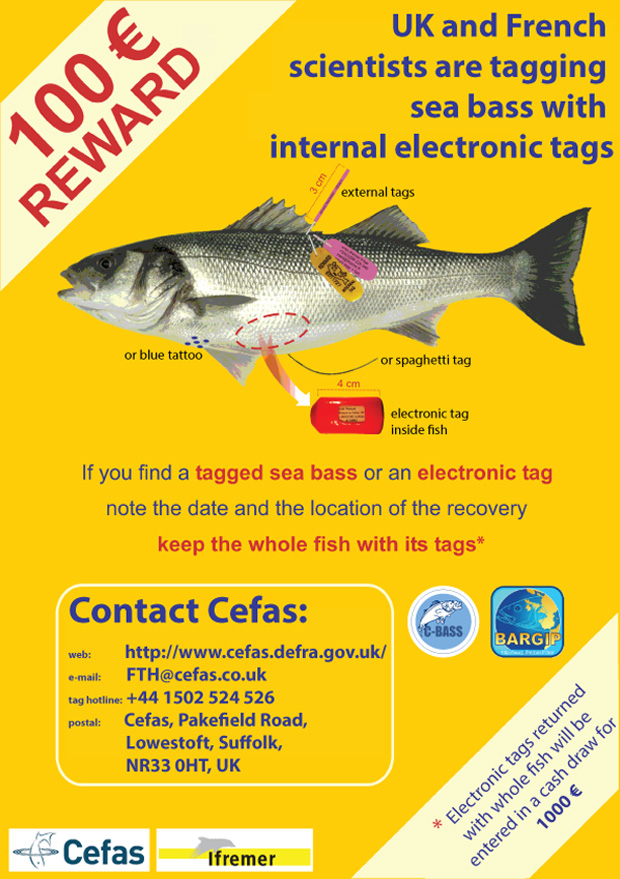Earlier this year, our first C-Bass Blog described the background and general aims of C-Bass - “Population studies in support of the Conservation of the European sea bass”.
Cefas-led and Defra-funded, our four-year study aims to help address key data gaps in several different areas of bass biology. Our work will provide much needed evidence in support in the conservation of this currently heavily exploited and declining stock.
Bass stocks are declining
The importance of C-Bass work has been reinforced by the most recent scientific advice from the International Council for the Exploration of the Sea (ICES), a global organization that develops science and advice to support the sustainable use of the oceans.
Their analysis of fishery and survey data since the 1980s shows that the overall abundance of adult bass in the North Sea, English Channel, Celtic Sea and Irish Sea grew rapidly from the mid 1990s onwards and reached a high point by around 2010.
However, the stock is being fished harder than is appropriate for such a slow growing, late maturing fish. To make matters worse, the number of young bass surviving from spawning in the years 2008 to 2012 appears to be well below average, probably due to unfavourable environmental conditions.
Although the stock has not collapsed, as suggested in some popular media, ICES has predicted that by 2016 the abundance of adult bass may fall close to the lowest previously observed which was in 1992. That is, unless the European Commission and Member States can urgently agree measures to substantially reduce the fishing pressure on the stock.
The future of the stock is also in the hands of the environment. Bass spawn offshore, preferring waters warmer than 9oC, and the area with favourable temperature can vary from year to year. Changes in environmental conditions can affect where bass spawn, and how many of their larvae reach the estuaries, harbours and salt marshes where, as juveniles, they spend the first few years of their lives.
Once inside these “nursery areas”, they are still not safe because cold conditions can kill them off or reduce their growth rates. Environmental conditions during the years 2008 and 2012 appeared unfavourable for bass, at least in the SE of England.
The good news is that last winter was very mild, and exceptionally warm sea conditions have been recorded around England and Wales throughout 2014. Perhaps because of this, the number of very young bass recorded by Cefas during its trawl survey in the Solent area of SE England in September this year was higher than observed for some time. It is still too early to predict exactly what sort of temperature extremes juvenile bass can hope to experience this winter.
By going back and analysing growth and distribution patterns in previous years, and applying sophisticated computer models to predict the dispersal of eggs and larvae from spawning grounds, C-Bass scientists hope to better understand how bass respond to a range of environmental factors. As a result, we can better predict how bass stocks will behave in the future, for example, in relation to rising sea temperatures.

What to do if you catch one of our tagged bass?
Cefas scientists have been working with our French colleagues in Ifremer by tagging and releasing bass tagged with electronic data storage tags (DSTs), which are placed inside the fish. We will describe our tagging work in detail in our following blog.
In order to ensure the highest possible standards, and consistency in our results, Cefas and Ifremer have adopted the same bass-tagging methods where possible. Animal welfare takes priority in all of the work that we do, and our scientists lead internationally with regards welfare standards. Our tagged fish have internally implanted DSTs located in the body cavity of the fish. Implanting the tags ultimately minimises any negative impacts of the tags on the tagged fish.
You can recognise DST-tagged bass from supplementary identification tags attached either from the dorsal fin or a spaghetti tag trailing below the anal fin. Additionally, the Ifremer fish also have a tattoo on the belly (see our joint Cefas-Ifremer reward poster, above). If you find a tagged sea bass, please take a note of where and when the fish was captured and keep the whole fish with its tags.
Our tags all have a bright orange flotation jacket, so even if a fish dies prior to being recaptured, the tags will float and will eventually wash up on a beach. Tag returns from beachcombers and sharp-eyed dog walkers have boosted our tag return rates in previous research programmes, sometimes by up to 10%, which makes a big difference to our results.
Some of our UK-based returnees found their language skills challenged after logging on to the Ifremer site, so to make tag returns (and the payment of associated rewards!) as easy as possible, all tags can now be returned through Cefas. In the coming weeks a single reward poster will be distributed (see below), encouraging the return of ALL DST-tagged bass in UK waters via Cefas, whether these originate from France or the UK.
You've got the tag or tagged fish, what next?
We need you to:
- note the date and location of the recovery
- freeze or put the whole fish on ice
Then contact Cefas, either by
- web: http://www.cefas.defra.gov.uk/industry-information/returning-tagged-fish-and-shellsh.aspx
- e-mail: FTH@cefas.co.uk
- telephone: +44 1502 524 526
- post: Cefas, Pakefield Road, Lowestoft, Suffolk NR33 0HT
For more information, signup to email updates on this C-Bass blog or contact ewan.hunter@cefas.co.uk.
You can also follow us on Twitter @CefasGovUK.